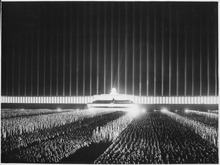Political leader


Political leader - in the early years also called "office administrator " - was a term used for office holders of the NSDAP . They had to take an oath on Adolf Hitler . The tasks of the political leaders, which included functionaries of the party from the block leader to the Reichsleiter , lay in particular in the political surveillance , propaganda orientation and ideological training of the parts of the population who were organized in the NSDAP. Initially trained in the Reichsfuhrer Schools , from 1937 onwards they were supposed toFührerauslese "complete their training in a staggered" educational system ", ranging from attending the Adolf Hitler Schools (six years), through" probation in the struggle for life "(seven years) and visiting the NS-Ordensburgen (four years) to " High school " was scheduled. This planning changed over time and was only partially implemented. After the end of World War II , the Political Leadership Corps was disbanded and classified as a " criminal organization " by the International Military Court .
Organization and status
Political leaders were deployed, among other things, to support the "sovereigns" who presided over the "sovereign territories of the NSDAP" ( block , cell, local group, district, district and Reichsleitung). In some cases they were also “sovereigns” themselves. Together with the other functionaries, who only had to deal with technical tasks, they formed the “Corps of Political Leaders”, which was used for the purpose of political conformity , was uniformed according to the military model and divided into ranks. Because of the golden brown uniform , the political leader was also popularly known as the "golden pheasant". In 1937 the group of political leaders comprised around 700,000 people.
The political leader was not an official in the legal sense . According to the guidelines of the party, he was considered a "public official". This even though he worked full-time from the district level upwards. According to the NSDAP opinion, the political leader should be “preacher and soldier” at the same time. But he was also an informer for the NSDAP who monitored the population; Political leaders had to create index cards about the residents of their “care area”, whose data they had to regularly supplement by filling out “general questionnaires”.
Dissolution of the corps
The "Corps of Political Leaders" as a structure of the NSDAP was declared a criminal organization in the Nuremberg Trial against the main war criminals in 1946 because it was jointly responsible for "the Germanization of incorporated areas, the persecution of Jews , the implementation of the slave labor program and the mistreatment of prisoners of war" . All Reichsleiter, Gauleiter and Kreisleiter were found guilty if they had been active after September 1, 1939. The Control Council Act No. 10 allowed penalties ranging from "partial loss of civil rights " to the death penalty , but the court recommended that the law be changed so that the punishment prescribed by the Denazification Act would not be exceeded in any case .
See also
Individual evidence
- ^ A b Rudolf Kluge , Heinrich Krüger: Constitution and administration in the Greater German Empire . 2nd, ed., Berlin 1939, p. 182.
- ↑ a b Willi Dreßen : Political leaders. In: Wolfgang Benz u. a. (Ed.): Encyclopedia of National Socialism . 5th, updated and expanded edition, dtv, Stuttgart 2007, p. 708, ISBN 978-3-423-34408-1 .
- ^ Rudolf Kluge, Heinrich Krüger: Constitution and administration in the Greater German Empire . 2nd, ed., Berlin 1939, p. 183 f. (Cited source: Robert Ley , VB of November 24, 1937.)
- ^ Whitney R. Harris : Tyrants in Court. The trial of the main German war criminals after the Second World War in Nuremberg, 1945-1946. Edited by Christoph Safferling. Berlin 2008, pp. 533 f., ISBN 978-3-8305-1593-7 .
- ↑ IMT: The Trial of the Major War Criminals. Reprint Munich 1984, Volume 22, pp. 567-75.